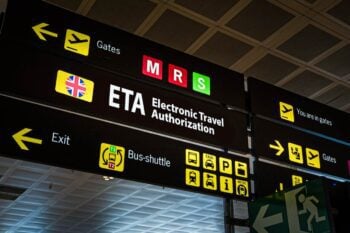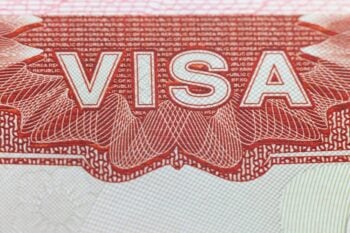
What You Need to Know About Europe’s New Entry Requirement
 Starting in 2027, travelers from 59 visa-exempt countries, including the United States, Canada, and the United Kingdom, must apply for a travel authorization called ETIAS (European Travel Information and Authorization System) before entering most European countries.
Starting in 2027, travelers from 59 visa-exempt countries, including the United States, Canada, and the United Kingdom, must apply for a travel authorization called ETIAS (European Travel Information and Authorization System) before entering most European countries.
ETIAS is not a visa, but a pre-travel clearance, similar to the U.S. ESTA or the U.K.'s ETA. It is designed to enhance security by screening travelers before they arrive and streamline border control across 30 European countries. Once approved, it allows short-term stays of up to 90 days within a 180-day period for tourism, business, transit, or medical purposes. If you're planning a trip to Europe, read on to learn who needs ETIAS, which countries require it, and how to apply.
Starting in 2027, travelers from 59 visa-exempt countries, including the United States, Canada, and the United Kingdom, must apply for a travel authorization called ETIAS (European Travel Information and Authorization System) before entering most European countries.
ETIAS is not a visa, but a pre-travel clearance, similar to the U.S. ESTA or the U.K.'s ETA. It is designed to enhance security by screening travelers before they arrive and streamline border control across 30 European countries. Once approved, it allows short-term stays of up to 90 days within a 180-day period for tourism, business, transit, or medical purposes. If you're planning a trip to Europe, read on to learn who needs ETIAS, which countries require it, and how to apply.
What is ETIAS?
ETIAS is a new entry requirement for nationals of countries that currently do not need a visa for short-term travel to Europe. It allows travelers to visit 30 European countries for tourism, transit, medical visits, or basic business activities.

Find the Best International Travel Insurance
- Get multiple quotes and coverage options
- Travel Medical, Trip Cancellation & more options available
- Find the best plan for your needs and budget
The main purpose of ETIAS is to improve security by digitally screening travelers before their arrival. The application cross-references your details against European and international security databases to ensure you do not pose a risk. ETIAS also helps streamline border control, allowing for quicker processing and reducing wait times at checkpoints.
Which Countries Require ETIAS?
A total of 30 European countries – including 27 European Union (EU) member states and Schengen-associated countries – will require ETIAS for entry.
This includes:
- Austria
- Belgium
- Bulgaria
- Croatia
- Cyprus
- Czech Republic
- Denmark
- Estonia
- Finland
- France
- Germany
- Greece
- Hungary
- Iceland
- Italy
- Latvia
- Liechtenstein
- Lithuania
- Luxembourg
- Malta
- Netherlands
- Norway
- Poland
- Portugal
- Romania
- Slovakia
- Slovenia
- Spain
- Sweden
- Switzerland
Read More: Schengen Visa Insurance Requirements
Who Needs ETIAS?
Once ETIAS is implemented, all travelers from visa-exempt countries must apply before visiting most European countries in the Schengen Area.
Currently, 59 countries and territories have visa-free access to Europe, including:
- Australia
- Brazil
- Canada
- Japan
- Malaysia
- Mexico
- Montenegro
- New Zealand
- Panama
- Serbia
- Singapore
- South Korea
- Taiwan
- Ukraine
- United Arab Emirates
- United Kingdom
- United States of America
For the complete list of eligible countries, visit the official ETIAS website.
Who Does Not Need an ETIAS Travel Authorization?
While most travelers from visa-exempt countries will need ETIAS, some individuals are exempt based on their nationality, residency status, travel documents, or specific circumstances.
This includes:
Nationals and Residents
- EU and Schengen citizens – Citizens of European countries participating in ETIAS do not need authorization.
- Legal residents – Those holding a valid residence permit or card from an ETIAS country are exempt.
- Nationals of visa-required countries – ETIAS does not apply; you must apply for a Schengen visa instead.

Special Country Exemptions
- UK nationals protected by the Withdrawal Agreement – Exempt with valid documentation proving this status.
- Citizens of Ireland, Andorra, San Marino, Monaco, and the Holy See (Vatican City) – These nationals are not subject to ETIAS requirements.
Document Holders
- Diplomatic, service, or special passport holders – May be exempt based on EU agreements with specific countries.
- Holders of long-stay visas, uniform visas, or local border traffic permits – ETIAS is not required while these documents remain valid.
- Travelers with official documents from international organizations – As defined in EU Decision No. 1105/2011/EU.
Special Circumstances
- Refugees, stateless persons, or those without nationality – Exempt if they reside in an ETIAS country with a valid travel document.
- NATO personnel – Exempt when traveling on official duty with valid ID and movement orders.
- Students, researchers, and intra-corporate transferees – May be exempt if traveling under certain long-stay or mobility programs covered by EU directives.
- Civilian air, sea, or inland waterway crew – Exempt depending on the rules of the destination country.
- Emergency personnel – Police, firefighters, and rescue workers on official cross-border missions may be exempt.
Traveling with Children or Family Members
Every traveler requiring an ETIAS must submit individual applications because the travel authorization is linked to a specific passport.
This means every family member, including children, will need their own ETIAS. The process for applying for minors is the same as for adults.
However, applications can be submitted by a third party. For example, a parent can apply for their child. Commercial intermediaries, such as travel agencies or law firms, can also apply on behalf of travelers.
Read More: Traveling With Children
How Will ETIAS Impact Travel Across Europe?
Generally, ETIAS will make travel to Europe safer and more efficient. All applicants will undergo a digital security screening, which helps ensure that only secure travelers are allowed entry.
Once approved, travelers can expect faster border processing, leading to smoother and more seamless travel throughout the Schengen Area.
ETIAS Validity and Duration of Stay
Once approved, an ETIAS travel authorization is generally valid for three years or until your passport expires, whichever comes first. Because it is electronically linked to your passport, you must apply for a new one if you renew or replace your passport.

ETIAS allows for multiple short-term entries into the Schengen Area, as long as both your passport and ETIAS remain valid.
However, each stay is limited to 90 days within any 180-day period. This rule applies across the entire Schengen Zone, not per individual country.
Although Cyprus is not part of the Schengen Area, it is included in the ETIAS system. However, time spent in Cyprus does not count toward your 90-day Schengen limit.
Protect Your Trip—Get Travel Insurance
While ETIAS makes your entry into Europe easier, it doesn't protect you from unexpected issues like flight cancellations, medical emergencies, or lost luggage. Travel insurance is strongly recommended–and sometimes required–for travelers visiting Europe.
How ETIAS Affects Long-Term Stays
ETIAS is a short-stay travel authorization. It does not grant the right to live, work, or study in Europe. If you plan to stay in Europe longer, you will need to apply for a national visa from the European country where you intend to stay. This applies if you want to live with family, study at a university, or work in any EU country.
Read More: Travel Insurance and Your Travel Visa
Impact on Frequent and Business Travelers
Frequent Travelers
For frequent travelers, ETIAS offers added convenience. Once approved, you won’t need to reapply before each trip, as long as your ETIAS and passport remain valid.
However, it's important to keep track of your time in the region to ensure you don’t exceed 90 days within any 180-day period.
This rule has always applied to visa-exempt nationals, so ETIAS doesn’t introduce any new restrictions – it simply adds an additional registration step.

Tip for frequent travelers: Consider purchasing annual travel insurance if you travel often. It can save money and hassle by providing continuous protection for multiple trips throughout the year. It includes benefits like medical coverage, trip cancellations, and lost luggage, making it a wise investment.
Business Travelers
For business professionals, the approval process for ETIAS offers a streamlined entry into Europe for meetings, conferences, and other essential business activities.
Once approved, you’ll be able to move through border control faster, ensuring that you can focus on your business agenda rather than administrative hurdles.

However, for longer business stays, such as extended work assignments or internships, you may still need a national visa.

Tip for group travelers: If you're traveling as part of a group, group travel insurance offers cost-effective coverage for trip cancellations, medical emergencies, lost luggage, and disruptions. It's ideal for family vacations, business trips, and events. Frequent travelers can also benefit from managing risks across multiple trips. Request a quote to find the best coverage.
When Will ETIAS Be Implemented?
Implementation Timeline
ETIAS is expected to be implemented in the last quarter of 2026, followed by a transitional period of at least six months.
During this time, travelers from visa-exempt countries should already apply for their ETIAS travel authorisation, but those without one will not be refused entry as long as they fulfil all remaining entry conditions.
After the transitional period, a grace period of at least six months will begin. During this time, travellers must have an ETIAS travel authorisation to enter the 30 European countries.
The only exception will be for travelers entering Europe for the first time since the end of the transitional period. They will be allowed to enter without an ETIAS, provided they meet all other entry requirements. All other travellers will be refused entry if they do not hold an ETIAS travel authorisation.
What Travelers Should Expect
Once ETIAS is live, the main change will be that citizens of visa-exempt countries must apply for ETIAS before traveling to Europe. Fortunately, the application process is quick, and travelers typically only need to apply once every three years.
When Does ETIAS Start for U.S. Travelers?
Implementation Date for U.S. Travelers
U.S. travelers will need to apply for ETIAS starting in 2027, after the grace period ends and ETIAS becomes mandatory for entry to Europe. The exact date has not yet been confirmed.
Implications for U.S. Travelers
U.S. citizens must apply for an ETIAS before traveling to Europe, so it’s important to plan ahead. If you’ve already been granted an ETIAS, be sure to check that it’s still valid before your trip.

Once in Europe, U.S. travelers with an approved ETIAS should be able to move through border control smoothly and enjoy their visit without any issues.
How to Apply for ETIAS
The ETIAS application process is straightforward and typically takes only a few minutes. However, you’ll need to ensure you have all the necessary documents, details, and a payment method available.
Documents Needed for ETIAS Application
To apply for ETIAS, you will need:
- A valid passport: This must be machine-readable and valid for at least three months beyond your intended stay.
- An active email address: This is needed to receive your ETIAS confirmation and updates.
- A credit or debit card: To pay the €7 application fee (if applicable).
You will also be required to answer questions about:
- Your travel history
- Any health conditions that may pose a public health risk
- Any past criminal convictions
- Your level of education and current occupation
It’s important to ensure all information you provide is accurate. Any false or incorrect details could delay your application or result in rejection.
Step-by-Step Application Process
Step 1: Access the Official ETIAS Portal
To begin, visit the official ETIAS website or download the mobile app. You’ll submit your application electronically through these official platforms.
Step 2: Complete the ETIAS Application
You’ll need to enter basic information about your identity and travel plans, including:
- Full name, date of birth, and nationality
- Passport details (passport number, issuance country, etc.)
- Contact information (email address, phone number)
- Travel details, including the country you will enter first within the Schengen Area
- Answer basic security and background questions.
The form should take approximately 10 minutes to complete.

Step 3: Pay the ETIAS Application Fee
Most applicants will need to pay a processing fee of €7 when submitting the application. This fee can be paid online using a debit or credit card (Visa, Mastercard, American Express, etc.).
Step 4: Submit Your Application and Wait for a Decision
Once you’ve submitted your form and payment, your application will be processed. In most cases, you’ll receive a decision within a few minutes, though some applications may take longer if additional security checks are necessary.
Step 5: Use your ETIAS
Once your ETIAS application is approved, you’ll receive a confirmation email. Your ETIAS is electronically linked to your passport, so you won’t need to carry a printed copy. However, border control officials still have the right to refuse entry into the Schengen area if they believe there’s a reason to do so.
Application Processing Time
Most ETIAS applications (about 95%) are processed immediately, so you will likely receive a decision within a few minutes.
However, if additional security checks are needed, the application could take up to 30 days to process. Because of this, it's best to apply for ETIAS at least a few weeks before your planned trip.
What Happens if Your ETIAS is Denied?
If your ETIAS application is denied, you will receive an email notification explaining the reason for the refusal. In this case, you will not be allowed to travel to countries that require ETIAS.
Common reasons for ETIAS denial include:
- There were incorrect or inconsistent personal details
- The travel document provided is reported as lost, stolen, or invalid
- You have a criminal record or are a security concern
- You have previous immigration violations in Europe
- There are health concerns
Appealing an ETIAS Denial
You have the right to appeal a denied ETIAS application. The rejection email will include instructions on how to appeal and identify the relevant authority to contact.
To file an appeal, you should:
- Check the denial email for instructions on the appeal process
- Submit any supporting documents that may help your case
- Contact the relevant EU country’s ETIAS office (this will be listed in the denial email)
There is a deadline for submitting an appeal. The exact time limit will be stated in the denial notice you receive. Be sure to act within that timeframe.
If you believe the denial was a mistake or due to incorrect information, you may also have the option to reapply with updated or corrected details, depending on the specific reason for the refusal.
Data Protection and Privacy
All information submitted through the ETIAS application is protected under strict EU data protection regulations. Authorities use advanced technology and security protocols to safeguard applicants’ personal data and prevent unauthorized access.
Additionally, electronic payment information is not stored by the ETIAS system and is handled exclusively by the bank or financial service provider processing the transaction.
Frequently Asked Questions (FAQs)
ETIAS is a travel authorization for short-term stays (up to 90 days) in the Schengen area. Unlike a visa, it cannot be used for long-term stays. ETIAS applies only to citizens of visa-exempt countries and does not grant the right to work or access public funds.
No, if you have a valid Schengen visa, you do not need ETIAS. ETIAS is for nationals who currently enjoy visa-free access to the EU. If you previously required a Schengen visa, you will continue to need it instead of applying for ETIAS.
Yes, ETIAS allows multiple entries to the Schengen area as long as it remains valid.
Yes, children, like all travelers, must have their own ETIAS. The application process is the same, but there is no fee for those under 18. Parents or guardians can apply on behalf of minors.
Most ETIAS applications are processed within a few minutes. However, if additional security checks are required, the application may take up to 30 days to process.
It is advisable to apply for ETIAS several weeks before your trip, as some applications may take up to 30 days to process.
If your ETIAS application is denied, you will receive an email explaining the reason(s) for the refusal. The email will also include information on how to appeal the decision.
If your ETIAS expires before your passport, you will need to apply for a new ETIAS. Additionally, if you receive a new passport, you must apply for a new ETIAS.




